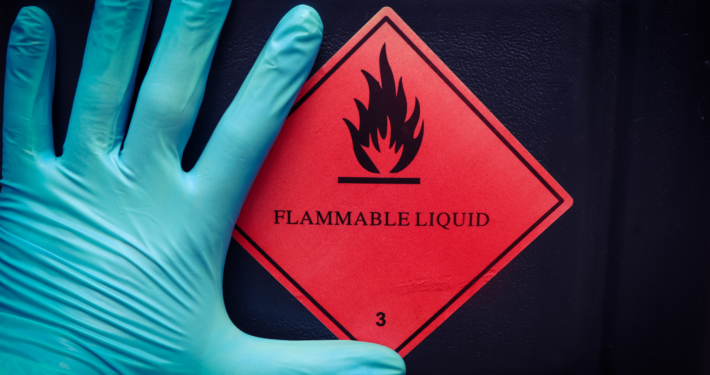Fire Safety in Healthcare & Industrial Facilities: The Benefits of Alcohol-Free Hand Sanitizers
Exploring The Advantages Of Benzalkonium Chloride-Based Sanitizers In High Risk Areas
By: Richard Rich
Hand hygiene is a crucial aspect of infection control in healthcare, food processing, and sterile environments. Alcohol-based hand sanitizers (ABHS) have become a widely used method for preventing the spread of germs and infections. However, it is important to consider the potential risks associated with the use of ABHS, particularly in terms of fire safety.
ABHS contains ethyl alcohol, which is a flammable liquid that readily evaporates into an ignitable vapor at room temperature. While the incidence of fires related to ABHS is low, it is vital that these products are stored safely and that bulk dispensers are correctly installed and maintained. To ensure fire safety, facilities should follow local and state fire safety laws and standards, and adhere to the National Fire Protection Association (NFPA) Life Safety Code 101. This code contains specific criteria for the storage and use of ABHS, including maximum dispenser fluid capacities and maximum quantities allowed in-use.
| Hand rub solution | Must not exceed 95% alcohol content by volume. (The Centers for Disease Control and Prevention recommends that ABHS contain at least 60% alcohol.) |
| Maximum dispenser fluid capacity | 1.2 liters (41 ounces, 0.32 gal) for dispensers in rooms, corridors, and areas open to corridors. 2.0 liters (67 ounces, 0.53 gal) for dispensers in suites of rooms separated from corridors. |
| Maximum quantity in aerosol containers | 18 oz., limited to Level 1 aerosols as defined by NPFA 30 B. |
| Maximum quantity of ABHS allowed in-use (i.e., in dispensers) | Ten gallons (37.8 L) in-use outside of a storage cabinet within a single smoke compartment. (Smoke compartment: A space within a building enclosed by smoke barriers on all sides, including the top and bottom.5) One dispenser per room off corridors is NOT included in the calculation. |
| Minimum corridor width | Six feet (1830 mm) wide |
| ABHS dispenser distance from ignition sources | One-inch (25 mm) distance (horizontal or vertical) above, to the side, or beneath an ignition source. (Sources of ignition: Appliances or equipment that, because of their intended modes of use or operation, are capable of providing sufficient thermal energy to ignite flammable gas-air mixtures.5 Examples include wall outlets, thermostats, and appliances.) Note: While one-inch is acceptable, a more conservative approach is to ensure a distance of no less than 6 inches (12.7 mm; horizontal or vertical, measured from the center of the dispenser) between ABHR dispensers and source of ignition. |
| ABHS dispenser separation | Horizontal spacing not less than 48 inches (1220 mm). |
| Carpeted areas | The smoke compartment must be equipped throughout with an approved automatic sprinkler system. |
| Operation of the dispenser | The dispenser shall:
Any activation of the dispenser shall only occur when an object is placed within 4 inches (100mm) of the sensor. |
| Storage outside of dispensers | In each smoke compartment, do not store outside of dispensers more than 5 gal (18.9 L) or an amount of ABHR that exceeds that which is necessary for normal maintenance of the area, whichever is less. |
| Maximum quantity for storage in a warehouse | Up to 120 gal (460 L). If need to exceed storage of 120 gal (460 L), consult with fire official.4 |
Source:: https://www.cdc.gov/handhygiene/firesafety/index.html
While ABHS is an effective method for preventing the spread of germs, it is not the only option available. Alternative hand sanitizers that do not contain alcohol are also available and can be a safer option for certain situations. One such alternative is benzalkonium chloride, which is an antimicrobial agent that is effective at killing germs and bacteria.
One example of a hand sanitizer that uses benzalkonium chloride is I.C. Foaming Sanitizer from R&R Lotion. This product is designed for use in healthcare setting and is formulated to kill 99.99% of germs and bacteria within 15 seconds of application. It is also alcohol-free, making it a safer option for use in areas where the risk of fire is a concern.
In addition to its fire safety benefits, benzalkonium chloride has several other advantages over alcohol-based hand sanitizers. It is less drying to the skin and can be used more frequently without causing irritation. It is also less likely to cause allergic reactions, making it a good option for individuals with sensitive skin.
While ABHS is an effective and convenient method for preventing the spread of germs, facilities should consider the potential risks associated with its use and consider alternative options when appropriate. Benzalkonium chloride-based hand sanitizers like I.C. Foaming Sanitizer from R&R Lotion can be a safer and more gentle option, particularly in situations where the risk of fire is a concern. By carefully selecting the most appropriate hand sanitizer for their needs, healthcare facilities can effectively prevent the spread of germs while also ensuring the safety of their staff and facilities.







